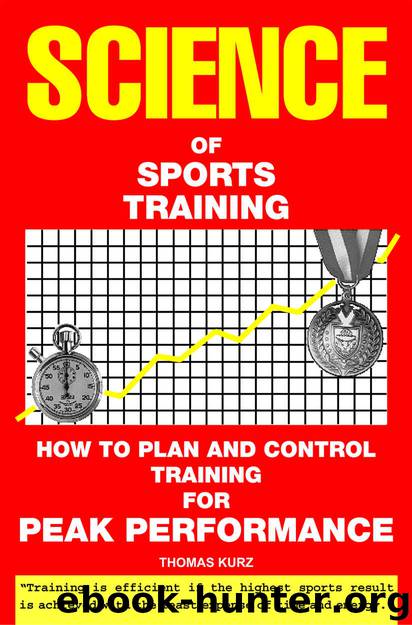Science of Sports Training: How to Plan and Control Training for Peak Performance by Thomas Kurz

Author:Thomas Kurz [Kurz, Thomas]
Language: eng
Format: azw3, epub
Publisher: Stadion Publishing Company, Inc.
Published: 2016-02-03T05:00:00+00:00
Speed Exercises in a Macrocycle
Speed exercises in the preparation period are done only if their character or the form of the athlete permits it. As a rule, speed exercises can be done at the beginning of the preparation period as long as the energy for them is provided mainly by the phosphocreatine system, or in other words, without raising the blood level of lactate above resting values (Wienecke and Gerisch 1989).
Speed exercises that require a foundation of strength or endurance to be effective and safe must be preceded by an adequate amount of strength and endurance training in the beginning of the preparation period.
In the general preparation period general speed exercises, such as sprints or ball games with the rules altered so speed is stressed, are used. The effect of these general speed exercises will be easily transferred only to those competitive exercises that are similar to them. For example, sprints will improve the speed of approach in jumps, but not the speed of boxing punches or the speed of evolutions on gymnastic apparatus.
In the sport-specific preparation period, speed exercises resemble either parts of or the whole of competitive exercises altered in such a way as to stimulate the development of speed. According to Sozanski and Witczak (1981), for advanced athletes it takes 6–8 weeks of sport-specific speed exercises to reach the maximal speed possible at their current stage of training. These 6–8 weeks may have to be preceded by 4–6 weeks of preparation including auxiliary training and general and directed speed training, especially for less advanced athletes. The total time required to reach the currently possible maximal speed depends on the complexity of the skills, so for sprinters lower time limits apply than for judo wrestlers.
Ceasing speed exercises for more than a week (10–14 days) causes a noticeable drop of speed (Sozanski, Witczak, and Starzynski 1999).
Next to be considered is endurance training.
Download
Science of Sports Training: How to Plan and Control Training for Peak Performance by Thomas Kurz.epub
This site does not store any files on its server. We only index and link to content provided by other sites. Please contact the content providers to delete copyright contents if any and email us, we'll remove relevant links or contents immediately.
Born to Run: by Christopher McDougall(7066)
Bodyweight Strength Training Anatomy by Bret Contreras(4614)
Dynamic Alignment Through Imagery by Eric Franklin(4119)
Men's Health Best by Men's Health Magazine(2551)
The Coregasm Workout by Debby Herbenick(2221)
Starting Strength by Rippetoe Mark(2079)
Relentless by Tim S Grover(2045)
Core Performance Essentials by Mark Verstegen(1982)
Endure by Alex Hutchinson(1967)
Bigger Faster Stronger by Greg Shepard(1946)
Weight Training by Thomas Baechle(1742)
Relentless: From Good to Great to Unstoppable by Tim S Grover(1652)
The Stretching Bible by Lexie Williamson(1557)
The Spartan Way by Joe De Sena(1535)
Practical Programming for Strength Training by Mark Rippetoe & Andy Baker(1531)
Good to Go by Christie Aschwanden(1447)
Dr. Jordan Metzl's Running Strong by Jordan Metzl(1383)
The Art of Throwing by Amante P. Marinas Sr(1355)
Total Hockey Training by Sean Skahan(1349)
